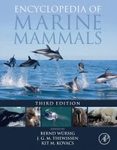About this book
Marine Mammals: Evolutionary Biology, Third Edition is a succinct, yet comprehensive text devoted to the systematics, evolution, morphology, ecology, physiology, and behavior of marine mammals. Earlier editions of this valuable work are considered required reading for all marine biologists concerned with marine mammals, and this text continues that tradition of excellence with updated citations and an expansion of nearly every chapter that includes full color photographs and distribution maps.
Contents
Preface
Acknowledgments
1. Introduction
1.1. Marine Mammals-""What Are They?""
1.2. Adaptations for Aquatic Life
1.3. Scope and Use of This Book
1.4. Time Scale
1.5. Early Observations of Marine Mammals
1.6. Emergence of Marine Mammal Science
1.7. Further Reading and Resources
References
PART I: EVOLUTIONARY HISTORY
2. Systematics and Classification
2.1. Introduction: Systematics-What Is It and Why Do It?
2.2. Some Basic Terminology and Concepts
2.3. How Do You Do Cladistics?
2.4. Testing Phylogenetic Hypotheses
2.5. Going Beyond the Phylogenetic Framework
2.6. Taxonomy and Classification
2.7. Summary and Conclusions
2.8. Further Reading
References
3. Pinniped Evolution and Systematics
3.1. Introduction
3.2 Origin and Evolution
3.3. Summary and Conclusions
3.4. Further Reading
References
4. Cetacean Evolution and Systematics
4.1. Introduction
4.2. Origin and Evolution
4.3. Summary and Conclusions
4.4. Further Reading
References
5. Sirenians and Other Marine Mammals:
Evolution and Systematics
5.1. Introduction
5.2. Origin and Evolution of Sirenians
5.3. The Extinct Sirenian Relatives-Desmostylia
5.4. The Extinct Marine Bear-Like Carnivoran, Kolponomos
5.5. The Extinct Aquatic Sloth, Thalassocnus natans
5.6. The Sea Otter, Enhydra lutris
5.7. The Polar Bear, Ursus maritimus
5.8. Summary and Conclusions
5.9. Further Reading
References
6. Evolutionary Biogeography
6.1. Introduction-What Is Biogeography and Why Is It Important?
6.2. Ecological Factors Affecting Distributions of Marine Mammals
6.3. Present Patterns of Distribution
6.4. Reconstructing Biogeographic Patterns
6.5. Past Patterns of Distribution
6.6. Summary and Conclusions
6.7. Further Reading
References
PART II: EVOLUTIONARY BIOLOGY, ECOLOGY,
AND BEHAVIOR
7. Integumentary and Sensory Systems
7.1. Introduction
7.2. Integumentary System
7.3. Nerves and Sense Organs
7.4. Summary and Conclusions
7.5. Further Reading
References
8. Musculoskeletal System and Locomotion
8.1. Introduction
8.2. Pinnipeds
8.3. Cetaceans
8.4. Sirenians
8.5. Sea Otter
8.6. Polar Bear
8.7. Summary and Conclusions
8.8. Further Reading
References
9. Energetics
9.1. Introduction
9.2. Metabolic Rates
9.3. Thermoregulation
9.4. Energetics of Locomotion
9.5. Osmoregulation
9.6. Summary and Conclusions
9.7. Further Reading
References
10. Respiration and Diving Physiology
10.1. Introduction
10.2. Problems of Deep and Prolonged Dives for Breath-Holders
10.3. Pulmonary and Circulatory Adaptations to Diving
10.4. Diving Response
10.5. Diving Behavior and Phylogenetic Patterns
10.6 Summary and Conclusions
10.7. Further Reading
References
11. Sound Production for Communication, Echolocation, and Prey Capture
11.1. Introduction
11.2. Sound Propagation in Air and Water
11.3. Anatomy and Physiology of Sound Production and Reception
11.4. Functions of Intentionally Produced Sounds
11.5. ATOC and Low Frequency Military Sonars
11.6. Summary and Conclusions
11.7. Further Reading
References
12. Diet, Foraging Structures, and Strategies
12.1. Introduction
12.2. Seasonal and Geographical Patterns of Prey Abundance
12.3. Adaptations for Foraging in Pinnipeds
12.4. Feeding Specializations of Cetaceans
12.5. Feeding Specializations of Sirenians
12.6. Feeding Specializations of Other Marine Mammals
12.7. Summary and Conclusions
12.8. Further Reading
References
13. Reproductive Structures, Strategies, and Patterns
13.1. Introduction
13.2. Anatomy and Physiology of the Reproductive System
13.3. Mating Systems
13.4. Lactation Strategies
13.5. Reproductive Patterns
13.6. Summary and Conclusions
13.7. Further Reading
References
14. Population Structure and Population Dynamics
14.1. Introduction
14.2. Abundance and Its Determination in Marine Mammals
14.3. Techniques for Monitoring Populations
14.4. Population Structure and Dynamics
14.6. Further Reading
References
15. Exploitation and Conservation
15.1. Introduction
15.2. Commercial Exploitation of Marine Mammals
15.3. Legal Framework for Marine Mammal Conservation and Protection
15.4. Incidental Taking of Marine Mammals
15.5. Environmental Contaminants
15.6. Single Beachings vs Mass Strandings
15.7. Ecotourism
15.8. Progress and the Future
15.9. Summary and Conclusions
15.10. Further Reading
References
Appendix: Classification of Marine Mammals
Glossary
Index
Customer Reviews
Biography
Annalisa Berta is Professor of Biology in the Department of Biology at San Diego State University, San Diego, California and a Research Associate at the San Diego Natural History Museum in San Diego, California and the Smithsonian Institution in Washington D.C. She is an evolutionary biologist who for the last 30 years has been studying the anatomy, evolution and systematics of fossil and living marine mammals, especially pinnipeds and whales. She is a past President of the Society of Vertebrate Paleontology and former Senior Editor of the Journal of Vertebrate Paleontology and Associate Editor of Marine Mammal Science. She has written 100 scientific papers and several books for the specialist as well as non-scientist including Return to the Sea: The Life and Evolutionary Times of Marine Mammals, 2012, and Whales, Dolphins and Porpoises: A Natural History and Species Guide.
James Sumich is Professor Emeritus of Biology at Grossmont College and is the author of a popular book on gray whales. He has conducted research on gray whales from British Columbia to Baja California for four decades and has taught marine mammal course for nearly that long. His research has focused on the ecological physiology of baleen whales, especially the energetics of their seasonal fasting migrations.
Kit M. Kovacs is the Biodiversity Research Programme Leader for the Norwegian Polar Institute in Tromsø Norway and Professor of Biology at University Studies on Svalbard (UNIS). She has worked with marine mammals in polar regions for the past 30 years, focussing on behavioural ecology and population biology. She is a Past-President of the Society for Marine Mammalogy and the current Chair of the Pinniped Specialist Group, International Union for the Conservation of Nature (IUCN).
















![Atlas des Mammifères Sauvages de France, Volume 1: Mammifères Marins [Atlas of Wild Mammals of France, Volume 1: Marine Mammals]](http://mediacdn.nhbs.com/jackets/jackets_resizer_medium/23/233077.jpg?height=150&width=108)


![Mexico Field Guides: Baja California - Sea of Cortez - Pacific Coast: Marine Mammals [English / Spanish]](http://mediacdn.nhbs.com/jackets/jackets_resizer_medium/13/139516.jpg?height=150&width=96)















